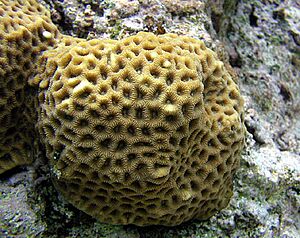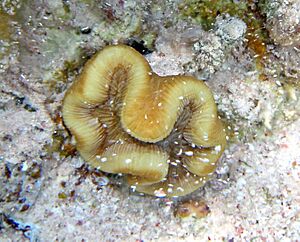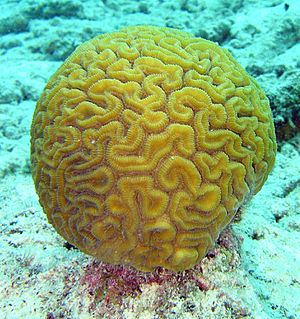Brain coral facts for kids
Quick facts for kids Brain coral
|
|
|---|---|
 |
|
| Favites abdita in the family Merulinidae | |
 |
|
| Manicina areolata in the family Mussidae (Faviidae) | |
| Scientific classification | |
| Kingdom: | Animalia |
| Phylum: | Cnidaria |
| Class: | Anthozoa |
| Subclass: | Hexacorallia |
| Order: | Scleractinia |
| Groups included | |
|
|

Brain corals are amazing ocean creatures! They get their name because they look a lot like a human brain, with their round shape and wavy, grooved surface. These corals are actually made up of many tiny animals called polyps living together in a colony. Each polyp helps build a hard home of calcium carbonate (which is like a natural rock). This makes brain corals super important for building coral reefs, just like other stony corals.
Contents
What are Brain Corals?
Brain corals are a type of coral found in warm, shallow ocean waters all around the world. They belong to a large group of animals called Cnidaria, which also includes jellyfish and sea anemones. Scientists also place them in a class called Anthozoa, which means "flower animals."
These corals can live for a very long time! Some of the biggest brain corals have lived for up to 900 years. Their colonies can grow quite large, sometimes reaching over 1.8 meters (about 6 feet) tall. Imagine a living structure taller than you!
Where Do Brain Corals Live?
You can find brain corals in the beautiful, colorful coral reefs of all the world's oceans. They prefer clear, shallow waters where sunlight can reach them. This is because they have tiny algae living inside their tissues that need sunlight to make food. These algae are very important helpers for the coral!
How Do Brain Corals Eat and Protect Themselves?
Brain corals are clever about getting their food. At night, when small drifting animals (called zooplankton) are active, the corals extend their tiny tentacles to catch them. During the day, they pull their tentacles back and wrap them over the grooves on their surface. This helps protect them.
Their hard, rocky surface is also a great defense. It keeps them safe from hungry fish and even strong ocean storms like hurricanes. While some other corals, like staghorn corals, grow faster, brain corals are tougher and can withstand more damage from storms.
Besides catching food, brain corals also get nutrients from the special algae that live inside them. It's a teamwork effort! Some types of brain corals, like those in the group Favia, can even defend their space by gently "stinging" other corals with special long tentacles at night. This helps them make sure they have enough room to grow.
Types of Brain Corals
There are many different kinds of brain corals, and scientists group them into various genera. Each genus has its own unique features, even though they all share that brain-like look. Some common examples include:
- Colpophyllia, often called boulder brain coral.
- Diploria, known as grooved brain coral.
- Favia, a very common type.
- Favites, which can also be called moon coral or pineapple coral.
- Manicina, another interesting type.
These are just a few examples of the many amazing brain corals that help build our ocean's reefs!
Images for kids
-
Brain coral spawning
-
Brain coral in the Caribbean Sea
-
Close-up of a brain coral near Nusa Kode Island, Indonesia
-
Closeup of Diploria strigosa in the Florida Keys
-
A fossil brain coral from the Pleistocene age
-
Diploria strigosa in the waters of Key West, Florida










